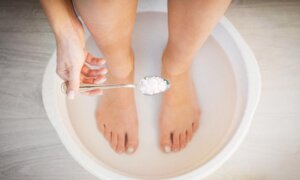Many people assume that dental issues and tooth loss are inevitable with age, possibly causing them to neglect their oral health. However, oral health is closely linked to overall well-being.
On the program “Health 1+1,” Dr. Glenn Ngan, a dentist and adjunct clinical assistant professor at New York University, discussed the importance of maintaining oral hygiene to prevent the recurrence of periodontitis and methods for choosing dentures. He stated that with proper care, teeth can remain healthy well into old age.
Periodontitis and Systemic Inflammation
Periodontitis is a chronic inflammatory disease that causes tooth loss and is
linked to several chronic inflammation-driven conditions, including cardiovascular and metabolic diseases, neurodegenerative disorders, autoimmune diseases, and cancer. Bacteria from periodontitis can enter the bloodstream, leading to bacteremia. Treatment of periodontitis often results in a reduction of systemic inflammatory markers.
“Gum inflammation can cause swelling, bleeding, and open sores,” Ngan said. “Bacteria from the mouth can enter the bloodstream, potentially affecting blood vessels and heart health and spreading inflammation throughout the body. Good oral health is crucial for overall well-being.”
Risks of Periodontitis
Periodontitis is a severe form of periodontal disease. The initial stage of periodontal disease is gingivitis, characterized by red, swollen gums that bleed easily but without significant discomfort,
according to the American Academy of Periodontology.
If left untreated, gingivitis can progress to periodontitis: Pockets form between the gums and teeth, allowing bacteria to accumulate. Over time, this can lead to the gradual recession of the gums and alveolar bone, ultimately resulting in tooth loss.
Can Periodontitis Be Cured?
If the gums no longer recede or bleed after treatment, the condition is generally well-controlled, Ngan said. Periodontitis can be effectively managed with treatment but requires ongoing attention to oral hygiene and regular dental checkups to prevent recurrence. However, if severe periodontitis has caused significant damage to the alveolar bone, reversing the damage becomes more difficult. Bone loss typically begins after age 30, and if treatment is delayed until the alveolar bone has severely deteriorated, even fitting dentures can become difficult.
Preventive Measures
According to Ngan, two dental checkups and cleanings are recommended each year. During these visits, the dentist will professionally remove plaque and tartar and address any detected periodontal issues early to prevent them from worsening and leading to complications such as tooth loss.
For those with periodontal disease, periodontists and other dentists offer deep cleaning (scaling and root planing). Tooth scaling removes plaque and tartar from the surface of the tooth and below the gumline, while planing removes plaque and tartar from the roots of the teeth.
In addition to seeing the dentist every six months, good oral hygiene is essential. Tooth decay and periodontal disease are caused by bacteria in the mouth, and proper cleaning helps prevent and manage these conditions, Ngan said.
Teeth Cleaning Tips
Ngan offers the following recommendations for effectively removing bacteria that cause tooth decay and periodontal disease:
- Rinse your mouth after meals
- Brush your teeth twice a day
- Use dental floss regularly to clean between your teeth
- Use an electric toothbrush
Drinking a glass of water after eating helps rinse away food particles from your mouth, Ngan said. High-fiber foods can leave residues stuck between teeth that are difficult to remove with a toothbrush alone. In such cases, dental floss can help dislodge the particles. For those with dentures, certain areas can be difficult to clean. A water flosser can be particularly useful for reaching these spots.
Ngan emphasized the importance of brushing your teeth twice a day. An electric toothbrush is also recommended, as it can make brushing more effective and enjoyable, especially for children.
The correct way to use an electric toothbrush is to gently place the brush head against your teeth and gum tissue, hold it in place for about 10 seconds, and then move it to the next area. Allow the electric toothbrush’s vibrations and rotation to do the cleaning rather than brushing back and forth manually.
Healthy gums should not bleed during brushing, Ngan said. If the bleeding persists for more than seven days, it is important to consult a doctor to identify the cause and restore your gums to a healthy state.
In addition to maintaining good oral hygiene, older people or those who have had dental work should avoid biting directly into hard foods such as hard candy, bones, or sugarcane, as excessive force could cause the tooth root to fracture, Ngan said.
Types of Dentures
If periodontitis leads to tooth loss, denture fitting becomes necessary. According to Ngan, fixed dentures generally offer better functionality than removable ones, but the choice depends on individual needs and conditions.
Removable dentures rest on the gums and are relatively easy to install and aesthetically pleasing, Ngan added. However, they can be uncomfortable during chewing because of pressure on the gums, especially if the alveolar bone has deteriorated. If some natural teeth remain, they can help stabilize the removable dentures. In cases in which no natural teeth are left, using two to four dental implants to support the removable dentures can provide better results than relying on removable dentures alone.
Fixed dentures, on the other hand, are permanently secured and cannot be removed daily. They offer better stability and chewing efficiency, making them feel closer to natural teeth. Fitting fixed dentures requires specific conditions, with some natural teeth being ideal. Without sufficient natural teeth, six to seven implants may be required to securely support larger fixed dentures.
A dental bridge and a denture serve similar purposes but differ in structure and application. A bridge replaces one or a few missing teeth by anchoring to the adjacent natural teeth or implants, while a denture typically replaces several or all teeth in a dental arch. Bridges are fixed and not removable, whereas dentures can be either removable or fixed, depending on the design and patient’s needs.
Minimally Invasive Dental Implants
Minimally invasive dental implant techniques involve drilling a small hole in the gum to place the implant without needing to lift the gum tissue, Ngan said. This approach results in a quicker procedure, smaller incisions, minimal bleeding, and faster healing.
Ngan described a dental implant case involving a patient missing two teeth in the upper jaw who sought implants. The dentist first recommended a CT scan to evaluate the bone condition. Using the scan images, he designed the implants, confirmed their placement with X-rays, and installed them. The entire procedure took about 30 minutes. The patient fully recovered within a week. After the implants were placed, the dentist continued to monitor the patient’s condition for three to six months before fitting the final dentures.
Timely dental restoration is crucial, Ngan emphasized.
“Don’t wait until you’ve lost several teeth to see a dentist,“ he said. ”The earlier periodontal issues are addressed, the more options you have for treatment and restoration. Protect your oral health—it’s the gateway to your overall health.”

(Courtesy of Dr. Glenn Ngan)

(Courtesy of Dr. Glenn Ngan)















